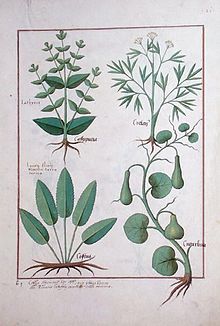
Pedanius Dioscorides, "the father of pharmacognosy", was a Greek physician, pharmacologist, botanist, and author of De materia medica —a 5-volume Greek encyclopedia about herbal medicine and related medicinal substances, that was widely read for more than 1,500 years. For almost two millennia Dioscorides was regarded as the most prominent writer on plants and plant drugs.
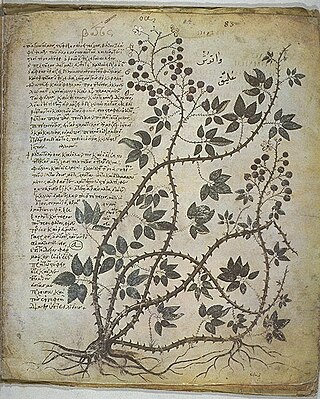
Materia medica is a Latin term from the history of pharmacy for the body of collected knowledge about the therapeutic properties of any substance used for healing. The term derives from the title of a work by the Ancient Greek physician Pedanius Dioscorides in the 1st century AD, De materia medica, 'On medical material'.
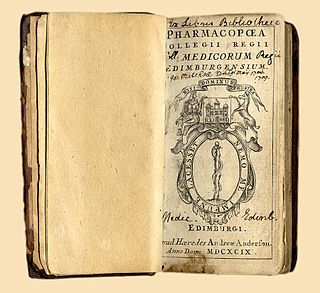
A pharmacopoeia, pharmacopeia, or pharmacopoea, in its modern technical sense, is a book containing directions for the identification of compound medicines, and published by the authority of a government or a medical or pharmaceutical society.
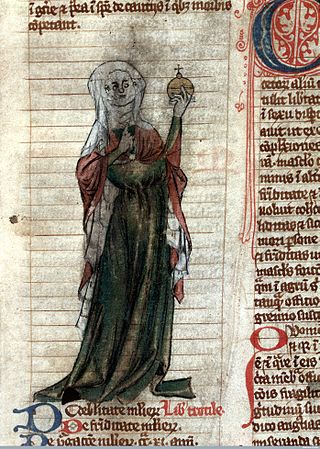
Trotula is a name referring to a group of three texts on women's medicine that were composed in the southern Italian port town of Salerno in the 12th century. The name derives from a historic female figure, Trota of Salerno, a physician and medical writer who was associated with one of the three texts. However, "Trotula" came to be understood as a real person in the Middle Ages and because the so-called Trotula texts circulated widely throughout medieval Europe, from Spain to Poland, and Sicily to Ireland, "Trotula" has historic importance in "her" own right.

Medieval medicine in Western Europe was composed of a mixture of existing ideas from antiquity. In the Early Middle Ages, following the fall of the Western Roman Empire, standard medical knowledge was based chiefly upon surviving Greek and Roman texts, preserved in monasteries and elsewhere. Medieval medicine is widely misunderstood, thought of as a uniform attitude composed of placing hopes in the church and God to heal all sicknesses, while sickness itself exists as a product of destiny, sin, and astral influences as physical causes. On the other hand, medieval medicine, especially in the second half of the medieval period, became a formal body of theoretical knowledge and was institutionalized in the universities. Medieval medicine attributed illnesses, and disease, not to sinful behaviour, but to natural causes, and sin was connected to illness only in a more general sense of the view that disease manifested in humanity as a result of its fallen state from God. Medieval medicine also recognized that illnesses spread from person to person, that certain lifestyles may cause ill health, and some people have a greater predisposition towards bad health than others.

A herbal is a book containing the names and descriptions of plants, usually with information on their medicinal, tonic, culinary, toxic, hallucinatory, aromatic, or magical powers, and the legends associated with them. A herbal may also classify the plants it describes, may give recipes for herbal extracts, tinctures, or potions, and sometimes include mineral and animal medicaments in addition to those obtained from plants. Herbals were often illustrated to assist plant identification.
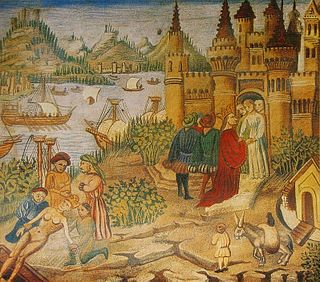
The Schola Medica Salernitana was a medieval medical school, the first and most important of its kind. Situated on the Tyrrhenian Sea in the south Italian city of Salerno, it was founded in the 9th century and rose to prominence in the 10th century, becoming the most important source of medical knowledge in Western Europe at the time.

Pseudo-Apuleius is the name given in modern scholarship to the author of a 4th-century herbal known as Pseudo-Apuleius Herbarius or Herbarium Apuleii Platonici. The author of the text apparently wished readers to think that it was by Apuleius of Madaura (124–170 CE), the Roman poet and philosopher, but modern scholars do not believe this attribution. Little or nothing else is known of Pseudo-Apuleius apart from this.

The Naples Dioscurides, in the Biblioteca Nazionale, Naples, is an early 7th-century secular illuminated manuscript Greek herbal. The book has 172 folios and a page size of 29.7 x 14 cm and the text is a redaction of De Materia Medica by the 1st century Greek military physician Dioscorides, with descriptions of plants and their medicinal uses. Unlike De Materia Medica, the text is arranged alphabetically by plant.

Medicine in ancient Rome was highly influenced by ancient Greek medicine, but also developed new practices through knowledge of the Hippocratic Corpus combined with use of the treatment of diet, regimen, along with surgical procedures. This was most notably seen through the works of two of the prominent Greek physicians, Dioscorides and Galen, who practiced medicine and recorded their discoveries. This is contrary to two other physicians like Soranus of Ephesus and Asclepiades of Bithynia, who practiced medicine both in outside territories and in ancient Roman territory, subsequently. Dioscorides was a Roman army physician, Soranus was a representative for the Methodic school of medicine, Galen performed public demonstrations, and Asclepiades was a leading Roman physician. These four physicians all had knowledge of medicine, ailments, and treatments that were healing, long lasting and influential to human history.

Serapion the Younger wrote a medicinal-botany book titled The Book of Simple Medicaments. The book is dated to the 12th or 13th century. He is called "the Younger" to distinguish him from Serapion the Elder, aka Yahya ibn Sarafyun, an earlier medical writer with whom he was often confused. Serapion the Younger's Simple Medicaments was likely written in Arabic, but no Arabic copy survives, and there is no record of a knowledge of the book among medieval Arabic authors. The book was translated to Latin in the late 13th century and was widely circulated in late medieval Latin medical circles. Portions of the Latin text make a good match with portions of a surviving Arabic text Kitab al-adwiya al-mufrada attributed to Ibn Wafid. The entire Latin text is very heavily reliant on medieval Arabic medicinal literature; and it is essentially just a compilation of such literature. It is exceedingly clear that the book was not originally written in a Latin language.

Matthaeus Silvaticus or Mattheus Sylvaticus was a medieval Latin medical writer and botanist.

The Baghdad School, also known as the Arab school, was a relatively short-lived yet influential school of Islamic art developed during the late 12th century in the capital Baghdad of the ruling Abbasid Caliphate. The movement had largely died out by the early 14th century, five decades following the invasion of the Mongols in 1258 and the downfall of the Abbasids' rule, and would eventually be replaced by stylistic movements from the Mongol tradition. The Baghdad School is particularly noted for its distinctive approach to manuscript illustration. The faces depicted in illustrations were individualized and expressive, with the scenes often highlighting realistic features of everyday life from the period. This stylistic movement used strong, bright colors, and employed a balanced sense of design and a decorative quality, with illustrations often lacking traditional frames and appearing between lines of text on manuscript pages.
The history of herbalism is closely tied with the history of medicine from prehistoric times up until the development of the germ theory of disease in the 19th century. Modern medicine from the 19th century to today has been based on evidence gathered using the scientific method. Evidence-based use of pharmaceutical drugs, often derived from medicinal plants, has largely replaced herbal treatments in modern health care. However, many people continue to employ various forms of traditional or alternative medicine. These systems often have a significant herbal component. The history of herbalism also overlaps with food history, as many of the herbs and spices historically used by humans to season food yield useful medicinal compounds, and use of spices with antimicrobial activity in cooking is part of an ancient response to the threat of food-borne pathogens.

De materia medica is a pharmacopoeia of medicinal plants and the medicines that can be obtained from them. The five-volume work was written between 50 and 70 CE by Pedanius Dioscorides, a Greek physician in the Roman army. It was widely read for more than 1,500 years until supplanted by revised herbals in the Renaissance, making it one of the longest-lasting of all natural history and pharmacology books.

The Hortus Sanitatis, a Latin natural history encyclopaedia, was published by Jacob Meydenbach in Mainz, Germany in 1491.
The Antidotarium Nicolai, also known as the Antidotarium parvum or small antidotarium, was a late 11th or early 12th-century Latin book with about 150 recipes for the creation of medicines from plants and minerals. It was written in the circles of the Schola Medica Salernitana, the center of European medical knowledge in the High Middle Ages. It was based in part on the Antidotarium of Constantine the African, an 11th-century work also written in Salerno which was itself partially a translation of older Arabic works. It has been called "without doubt one of the most influential medical texts in medieval literature", "the essential pharmacopeia of the Middle Ages" and "the bible of medieval practical pharmacy". It was often coupled with the Circa instans, another 12th-century compendium of less complex medicines.
Tadhg Ó Cuinn, Irish scribe and author, fl. October 1415.

Herbarius moguntinus or Aggregator practicus de simplicibus is an illustrated Latin herbal which was edited and printed in 1484 by Peter Schöffer in Mainz. Together with the German herbal Gart der Gesundheit and the Latin herbal Hortus sanitatis, Herbarius moguntinus belongs to the so-called "Group of Mainz Herbal Incunabula."
